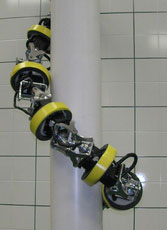Three pole-climbing serpentine robots have been developed by engineers at the Robotics and Mechanisms Laboratory (RoMeLa) of the
The robots could take the place of construction workers tasked with dangerous jobs such as inspecting high-rises or underwater bridge piers.
The three robots - the HyDRAS-Ascent (Hyper-redundant Discrete Robotic Articulated Serpentine for climbing), the HyDRAS-Ascent II and the CIRCA (Climbing Inspection Robot with Compressed Air), recently took the grand prize at the 2008 International Capstone Design Fair.
The autonomous robots are designed to climb scaffolding and buildings by wrapping around a poll or beam and then rolling upward via an oscillating joint motion.
Using built-in sensors and cameras, the robots would then inspect the structures or handle other dangerous tasks now done by humans, said Dennis Hong, director of Virginia Tech’s Robotics and Mechanisms Laboratory and the faculty adviser on the project.
The robots are each roughly three feet in length and use a movement unique even in nature.
'Unlike inchworm type gaits often being developed for serpentine robot locomotion, this novel climbing gait requires the serpentine robot to wrap around the structure in a helical shape and twist its whole body to climb or descend by rolling up or down the structure,' Hong said.

The HyDRAS serpentine robot prototype climbs a pole by converting the oscillating motion of the joints to a whole-body rolling motion to climb-up pole-like structures
The HyDRAS robots operate using electric motors, while the CIRCA robot uses a compressed-air muscle.
Presently, the three robots operate by a tethered wire attached to a laptop, but Hong and his students are reconfiguring the devices to function independently using an onboard microprocessor and power source.
'This family of novel robots will serve as a practical inspection tool for construction sites without putting workers in harm’s way,' he added.




Poll: Should the UK’s railways be renationalised?
The term innovation is bandied about in relation to rail almost as a mantra. Everything has to be innovative. There is precious little evidence of...